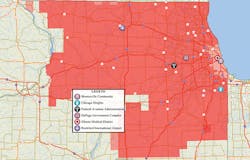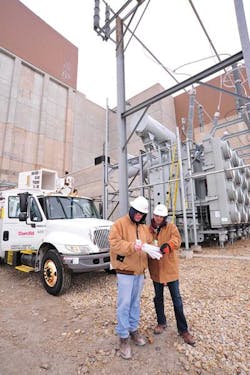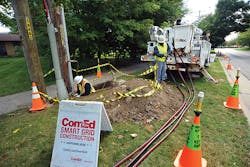The electric utility industry is in the middle of an unmatched evolution driven by a combination of emerging new technologies, regulatory mandates and economic incentives. Utilities must provide a secure, resilient supply of electricity to consumers. In tension with this goal is an unprecedented increase of operational uncertainties resulting from the use of renewables and other distributed generation. This all makes the case for revisiting the traditional utility business model with an eye toward embracing and leveraging new technologies.
Commonwealth Edison (ComEd), the electric utility serving the greater Chicago area and northern Illinois, U.S., is taking a proactive approach to address these emerging challenges while ensuring a sustainable and viable future for energy in Illinois. ComEd’s proposal for Illinois’ energy future, which it recently submitted to the Illinois General Assembly, focuses on eight timely and important enablers:
• Expanding energy efficiency to voltage optimization
• Promoting solar power for communities
• Implementing demand-response facilitation services
• Creating rate design modifications to enable equitable cost allocation
• Allocating additional financial assistance for customers in need
• Supporting transportation electrification by installing public electric vehicle charging stations
• Enhancing renewable portfolio standards
• Developing a microgrid pilot program.
The microgrid proposal, in particular, is a ground-breaking utility-initiated program that aims to address the security and resiliency of the electric supply to the critical infrastructure within ComEd’s service territory. Microgrids represent an exemplary utility-of-the-future solution by using state-of-the-art technologies to address multiple performance and design objectives including resiliency, efficiency, sustainability, reliability, power quality and integration of distributed energy resources (DERs).
Microgrid Benefits
The integration of microgrids can increase grid efficiency through peak demand reduction and reduced losses in transmission and distribution systems. Microgrids also can be used to provide ancillary services to improve grid operations and power quality to facilities that require high-standard services. The addition of renewable generation in microgrids can assist utilities in meeting mandated renewable portfolio standards.
But perhaps the most important application of microgrids is the potential ability to reduce vulnerabilities to extreme weather events as well as to physical and cyber attacks. According to the U.S. Department of Energy (DOE), the nation loses between US$18 and $33 billion annually as a result of power outages. With the increasing severity and frequency of extreme weather events, strategically placed microgrids could provide an added level of resiliency to the critical infrastructure.
For the proposed microgrid implementations, ComEd would adhere to the DOE’s microgrid definition: “A microgrid is a group of interconnected loads and DERs within clearly defined electrical boundaries that acts as a single controllable entity with respect to the grid and that connects and disconnects from such grid to enable it to operate in both grid-connected and islanded modes.”
In line with this definition, ComEd would require its microgrids to include multiple loads and generation resources, operate as part of the grid and separate from the grid, and be controlled by a centralized microgrid controller. For the DER installations within the microgrids, ComEd is considering combined heat and power, fuel cells, energy storage systems, photovoltaics and diesel generation.
Microgrids, in addition to improving security and resiliency, can help to revitalize the economies of areas where they will be deployed. The microgrid pilot program is envisioned to attract businesses to maximize job creation. The investments in these technologies not only create jobs but also increase the economic stability in the areas where they are installed. As microgrids provide stable, secure, resilient and reliable electric supply, they provide a great environment for advanced manufacturing and research, which are often sensitive to grid disturbances and outages. A good example of how the pilot program provides value to local economies is how it adds operational reliability to transportation infrastructure during an extreme event.
The Pilot Program
The proposed legislation, presented to the Illinois General Assembly, would enable an investment of up to $250 million in six microgrid pilots to support critical infrastructure and facilities within the ComEd service territory. ComEd’s customers would be the main beneficiaries of this program. The proposed locations were carefully selected to demonstrate applications of microgrids for multiple types of infrastructure required to operate during extreme conditions. The targeted critical infrastructure includes water, transportation, health care, community and local government.
Prior to the site selection, ComEd leveraged its partnerships with several external agencies — including the DOE, Department of Homeland Security, Illinois Emergency Management Agency and the City of Chicago Office of Emergency Management and Communications — to broaden the analysis around the critical infrastructure. In selection of these sites, ComEd adopted a holistic, data-driven approach to evaluate its power delivery infrastructure over the entire service territory for potential microgrid locations. The resiliency metrics included data related to critical infrastructure and customers, input from external stakeholders and existing power delivery infrastructure.
Multiple components were considered in the evaluation of power delivery infrastructure including, but not limited to, reliability metrics, the need for capacity upgrades, N-1 contingency, transmission congestion, substation upgrade and projected load at-risk conditions.
The approach divided ComEd’s service territory into 1-mile by 1-mile (1.6-km by 1.6-km) sections outside the city of Chicago and into 0.5-mile by 0.5-mile (0.8-km by 0.8-km) quarter sections within the city of Chicago. The division of the service area to the small sections enabled a robust geographic information system (GIS)-based visualization of candidate areas. All the sections were evaluated in terms of the critical customer information, existing power delivery infrastructure, feedback from external stakeholders and multiple other factors.
Each of the factors contributed to a weighted summation to establish the overall section’s resiliency score. The approach formed the comprehensive resiliency metric, which considers all the key factors that drive the decisions for microgrid locations. All the data was entered in a common database, and the results were shown with a mapping tool to highlight candidate areas for microgrid installations.
Proposed Microgrid Locations
The proposed six locations selected based on the service territory study include a mix of critical facilities in diverse geographic locations. The pilot program would enable ComEd to demonstrate how microgrid technology can provide security and resiliency to multiple types of critical facilities. While the program only includes six locations, the study revealed several other locations that could be considered as potential future microgrid installations.
Following are brief highlights of each of the six locations proposed as part of the microgrid pilot program:
• Bronzeville Community is located on the south side of Chicago. The pilot microgrid would be built around the resilient community concept. The neighborhood includes critical infrastructure as well as a representative cross-section of diverse customer classes within the city of Chicago. The Bronzeville microgrid would also be integrated with the existing campus microgrid at the Illinois Institute of Technology and form a microgrid cluster where the two microgrids would operate in conjunction and share resources. In support of the clustered community microgrid concept, ComEd was awarded a DOE grant to develop an advanced microgrid controller for controlling microgrid clusters.
• Chicago Heights is a suburb located south of the city of Chicago. The proposed microgrid in Chicago Heights would be an installation around several facilities supporting the water infrastructure in the area. The proposed footprint includes water pumping and treatment facilities along Thorn Creek. Besides Chicago Heights, these facilities provide water and wastewater treatment services to eight surrounding suburbs serving nearly 100,000 people. In case of an emergency, the continued supply of clean water is essential for the population.
• The DuPage County government complex is located in Wheaton, Illinois, a far western suburb of Chicago. The complex includes administrative buildings, a youth home, a county health department, a judicial building, a sheriff department, a highway department, a county jail and emergency management offices, all within a small footprint, which makes the area a good candidate for a microgrid installation. During the discussions with external stakeholders, the continued operation of local government during emergency conditions was identified as a high priority.
• The Federal Aviation Administration facility in Aurora has a major impact to the air traffic in North America. A fire event at the facility in the fall of 2014 disrupted air traffic across the U.S. The
microgrid would add resiliency to the power supply of the facility and stability to the air traffic infrastructure overall. The location of the facility would allow for extension of the microgrid to the neighboring hospital, schools, health department and blood center.
• The Illinois Medical District is located west of the Chicago downtown business district. The area consists of several major hospitals and other critical infrastructure, all within a small urban footprint. The microgrid would demonstrate the benefits of a microgrid to the health care infrastructure and, because of its central location, demonstrate the benefits to a large number of ComEd customers.
• Rockford International Airport is located in the western part of ComEd’s service territory. Along with some passenger traffic, the airport is a major hub for air cargo. The proposed microgrid would support critical facilities for the airport and thus support the cargo and transportation infrastructures within the region. Because of the significance of the airport as a cargo hub, any disruption to its operations could impact the economy within the ComEd service territory.
Microgrid Controller
In September 2014, the DOE announced ComEd was selected to receive a $1.2 million grant to develop a commercial-grade microgrid controller capable of controlling clusters of microgrids. Under this funding opportunity, ComEd was the only utility-led effort selected to receive a grant. The controller will be capable of operating two or more microgrids in conjunction with each other and enable functions including, but not limited to, islanding, synchronization and economic dispatch.
ComEd and its partners are on track to complete the controller development by August 2016. The utility envisions applying the controller to the proposed microgrid installations. These efforts for the controller development have enabled the utility to take an industry leadership role, especially in the IEEE Standard 2030.7 – Distribution Resources Integration, Microgrid Controllers Working Group, which ComEd is vice chairing.
Grid Investment
The rising cost of weather-related outages has driven significant developments and investments toward grid resiliency. Additionally, aging infrastructure is a concern across the country. As a proactive utility, ComEd is taking significant leaps toward addressing the aging infrastructure and improving grid resiliency in northern Illinois, enabled by the Energy Infrastructure Modernization Act. The proposed microgrid program would leverage state-of-the-art grid technologies to further improve the resiliency of the power delivery infrastructure in supporting critical facilities and customers.
The goal of the program is to demonstrate how microgrids can be applied to protect the critical infrastructure required to remain in operation during catastrophic events. The industry consensus is microgrids will become an integral part of the future integrated grid. The proposed pilot program would further allow ComEd to gain valuable experience in innovative technologies to create more value for ComEd’s customers. The investment for the pilot program today will result in more resilient, reliable and efficient electric service in the future.
Aleksi Paaso ([email protected]) is a senior smart grid specialist with ComEd smart grid and technology. Paaso’s areas of specialty include voltage optimization and microgrids. He is heavily involved in ComEd’s Department of Energy-funded effort to develop a microgrid master controller for clustered microgrid applications. He is also a member of IEEE and CIGRE.
Shay Bahramirad ([email protected]) is director of smart grid and technology at ComEd and an adjunct professor at the Illinois Institute of Technology. Bahramirad is a senior member of the IEEE, technical chair of the 2014/2016 IEEE PES T&D Conference and technical chair of the Great Lake Symposium on Smart Grid. She serves as the vice chair of the PES distribution subcommittee and as vice chair of the IEEE standard on microgrid controller.
Henry Pierce ([email protected]) is in the smart grid and technology department at ComEd. His ongoing work focuses on emerging technologies, including microgrids, energy storage, voltage and current unbalances, and smart city applications that leverage ComEd’s physical and communications network. He is also a member of IEEE.
Editor’s note: The views expressed herein are entirely those of the authors and do not necessarily represent the views of ComEd.
About the Author
Aleksi Paaso
ALEKSI PAASO ([email protected]) is director of distribution planning, smart grid and innovation at ComEd, where he is responsible for distribution planning activities, distributed energy resource (DER), and smart grid strategy and project execution. He is a senior member of the IEEE and vice chair of the IEEE Power & Energy Society’s (PES) Industry Technical Support – Leadership Committee (ITS-LC). He holds a Ph.D. in electrical engineering from the University of Kentucky.





